Antinol® Latest Studies
Sorted by recent
 Filter Studies by Smart Tags
Filter Studies by Smart Tags
Bone & JointCardiovascularCase Study & ProceedingCatDogEAB 277™EfficacyExotic PetImmunologyNeuro & BehaviorOphthalmologyOralRabbitRenalRespiratoryRodentSafetySkinUTI
Smart Search
Report Clinical Results of Feline Patients with Chronic Kidney Disease (CKD) that received PCSO-524® Vol.9 (2018 September)

Chronic Kidney Disease in cat(1) treated with Antinol®
Mongrel Cat, 7 years old was admitted to Maizuru Animal Medical Center, patient was diagnosed with CKD
Overview: Patient was not responding to treatment but decrease in BUN and Creatinine (Are) levels were observed after Antinol® was added to treatment regimen.
(Addition of Antinol® to treatment: 1st 2 weeks; 2 caps / day orally. Continued with 1 caps / day orally.)

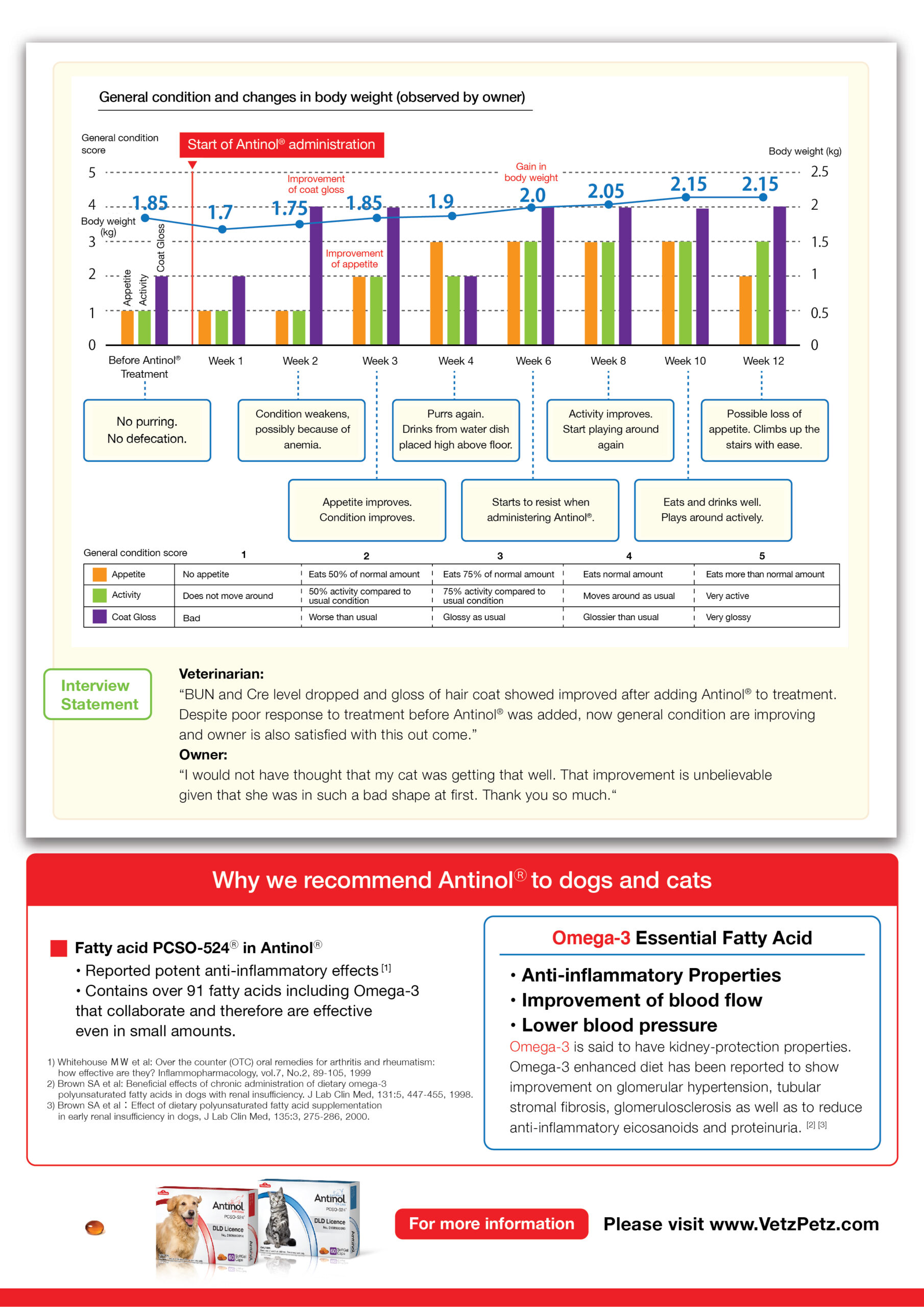
PCSO-524® (Antinol®) Use in Persian Cat with Dynamic Hypertrophic Obstructive Cardiomyopathy (HOCM)

A Persian cat aged 21 years was diagnosed with Dynamic Hypertrophic Obstructive Cardiomyopathy (HOCM) and treated with PCSO-524® (Antinol®) for 45 days.
The cat regained quality of life and daily activities such as grooming and walking, increased appetite, ingestion and weight gain after the treatment. Serum Amyloid A (SAA), which is an inflammatory marker in cats, was reduced down to normal after 15 days of PCSO-524® (Antinol®) administration.
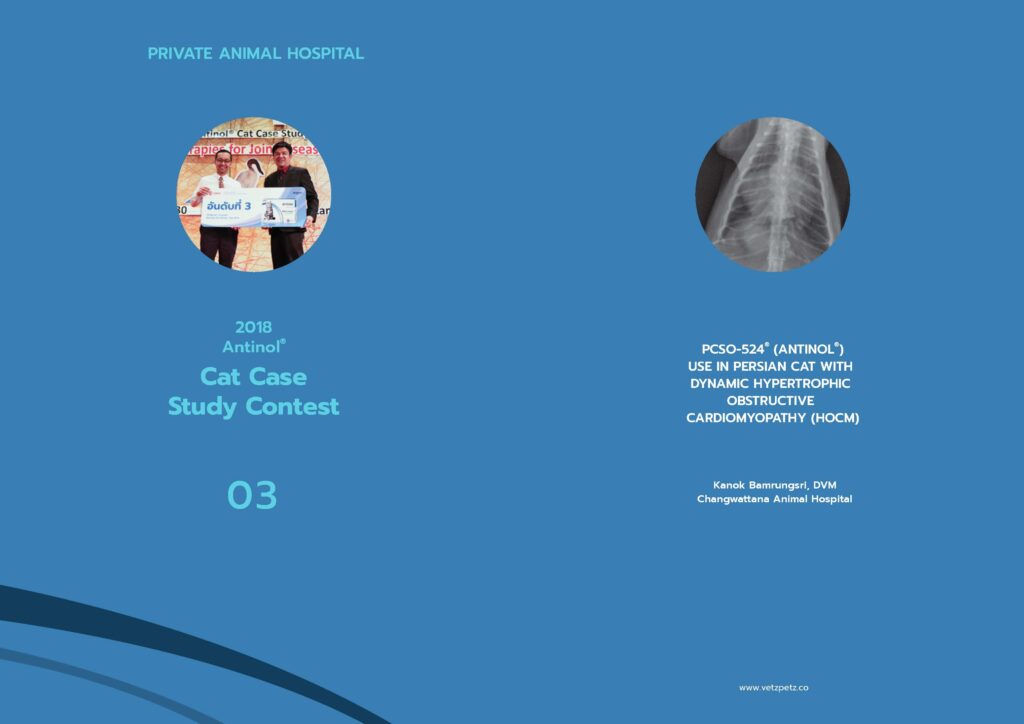
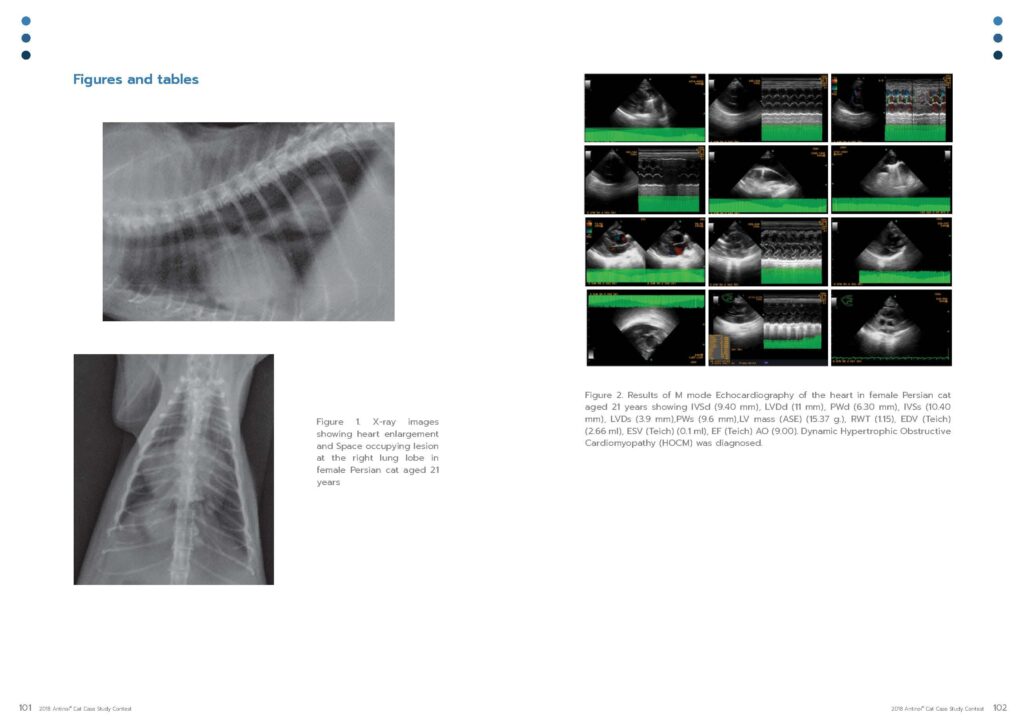
Use of PCSO-524® (Antinol®) and Antipruritic Drug for Treatment of Itch Caused by Flea Allergy Dermatitis (FAD) and Psychological Alopecia in Domestic Short Hair Cat

The cat in this case was affected with skin disease caused by flea allergy dermatitis (FAD) and psychological alopecia.
Holistic treatment was the choice of treatment in this case. Medical treatment was applied to the cat and environments surrounding the cat was managed. PCSO-524® (Antinol®) in combination with other antipruritic drugs was used to relieve itch and inflammation of the chronic skin disease and to strengthen the skin.
During 210 days of the study, environment was managed and intensive parasitic control was applied to every cat in the house in order to control flea. The study showed efficacy of PCSO-524® (Antinol®) for treatment of skin inflammation, strengthening the skin, and itch relief.
During day 160-210 of the treatment, administration of other anti-itch drugs was terminated due to psychological alopecia that caused constant licking by the cat. PCSO-524® (Antinol®) was recommended in this case since it can be used for long-term treatment without adverse effects.
The study concluded that PCSO-524® (Antinol®) in combination with other antipruritic drugs and environmental management is effective.


Use of PCSO-524® Along with Physical Therapy for Controlling Pain and Inflammation in a Cat Suffering from Osteoarthritis, Chronic Kidney Disease and Triaditis

A spayed female domestic shorthaired cat aged 21 years and weighed 4.2 kilograms with history of chronic kidney disease and triaditis was referred to Suvarnachad Animal Hospital.
The cat showed signs of both hind limb weakness, limp tail and pain around posterior body part. Other signs included polydipsia, polyuria, and diarrhea. Radiographic examination revealed osteoarthritis at lumbosacral joint, elbow and both stifle joints. Hematological and blood chemistry tests showed mild anemia, neutrophilic leukocytosis, increased serum amyloid A and Increased Feline pancreatic lipase.
Administration of PCSO-524® and physical therapy were provided to reduce systematic and local pain and inflammation. The supportive treatment was continued for 15 months, during the first 2 months of which, the lumbosacral joint painwas reduced and then disappeared after 5 months. The control of elbow and knee joint pain was satisfied for the whole treatment period.
The cat was able to move the tail and resume normal walking after the 1st and 5th month of the treatment, respectively. Ability to jump and climb returned in the 5th and 8th month. However, the cat had improved defecation within 3 months. Testing of feline pancreatic lipase and serum amyloid A showed normal levels after 7 months of the treatment.
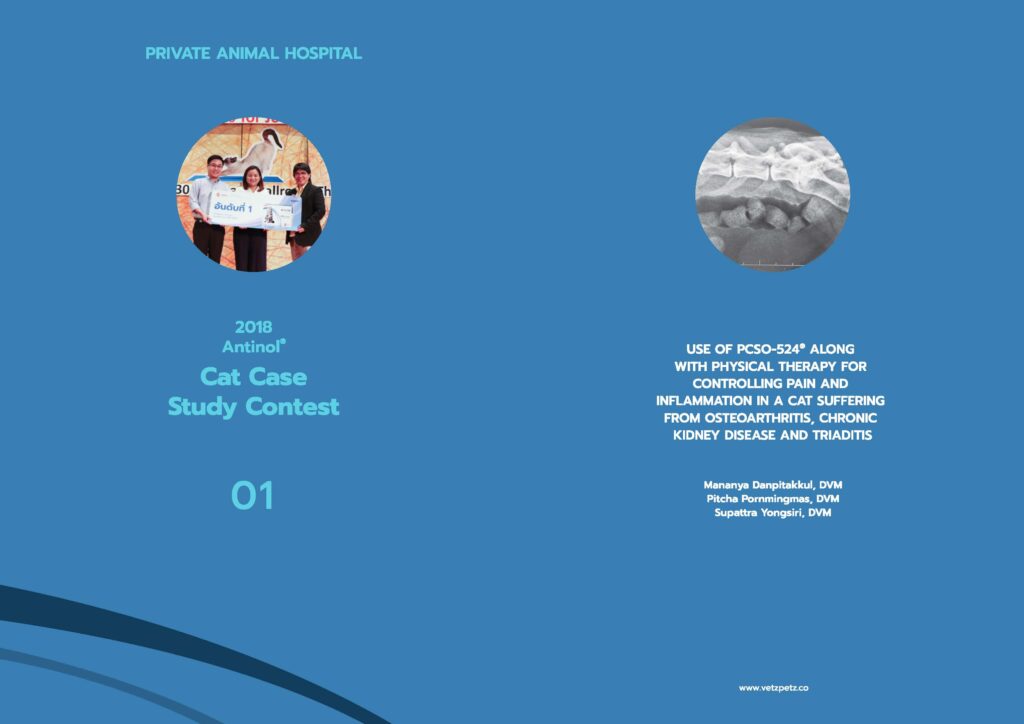
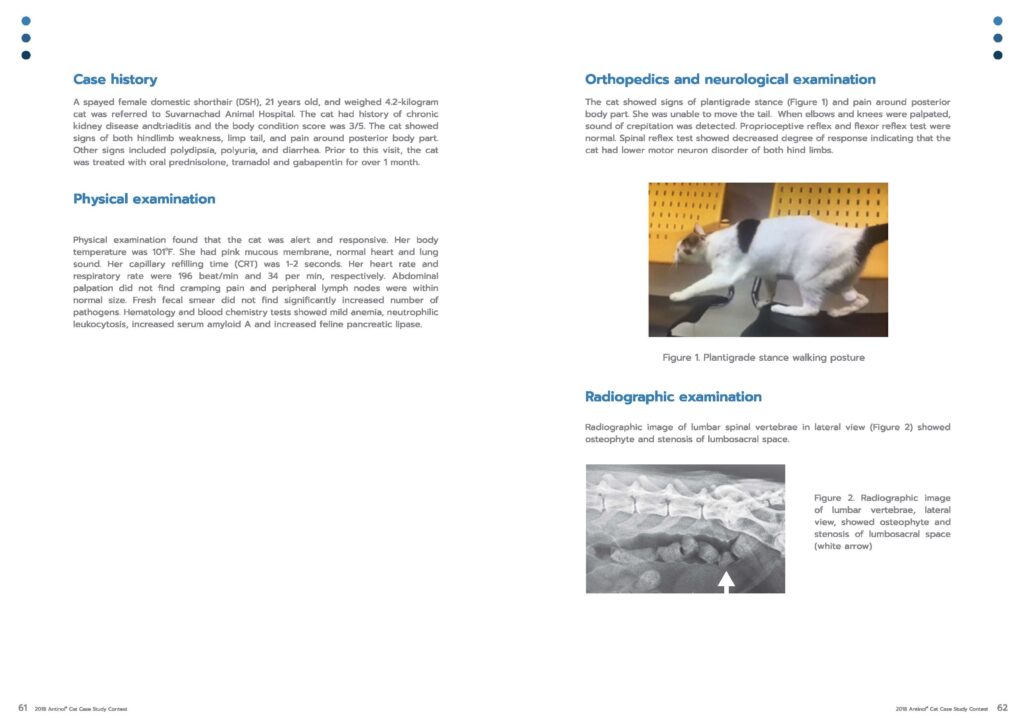
Use of PCSO-524® for Control of Inflammation Caused by Iris Tumorand Uveitis in Cats with Lymphoma and Chronic Kidney Disease

A neutered male Domestic Shorthair cat aged 8 years was infected with FIV and diagnosed with nasal submucosa-T-cell lymphoma that was positive to CD3.
Four months later, tumor of iris and uveitis were found in the left eye. Treatment of inflammation of the left eye included prednisolone acetate 1% eye drop (lnf-oph® 1 %, Seng Thai company; Thailand) qid, doxycycline (Siadocin®, Siam Bheasach; Thailand) PO at the dose 10 mg/kg/day, prednisolone (Prednisolone GPO; Thailand) PO0.36 mg/kg bid.
Two weeks later, the size of tumor remained constant, the inflammation degree was reduced but creatinine level was increased. Administration of oral prednisolone, not the eye drop, was then terminated. Uveitis of the right eye was diagnosed and also fibrin in the anterior chamber and tumor of the iris were found in the right eye. Prednisolone acetate 1% eye drop was prescribed for both eyes.
The inflammation of both eyes still existed after 1 month of the prednisolone treatment. Green Lipped mussel extract, PCSO-524® (VetzPetz Antinol®, DKSH, Thailand), 1 capsule per day was then prescribed as an alternative of steroidal medication for control of inflammation, together with the prednisolone acetate 1 % eye drop in both eyes.
After 30 days of the start of PCSO-524® treatment, the tumor of iris disappeared and the severity of uveitis was reduced in both eyes.
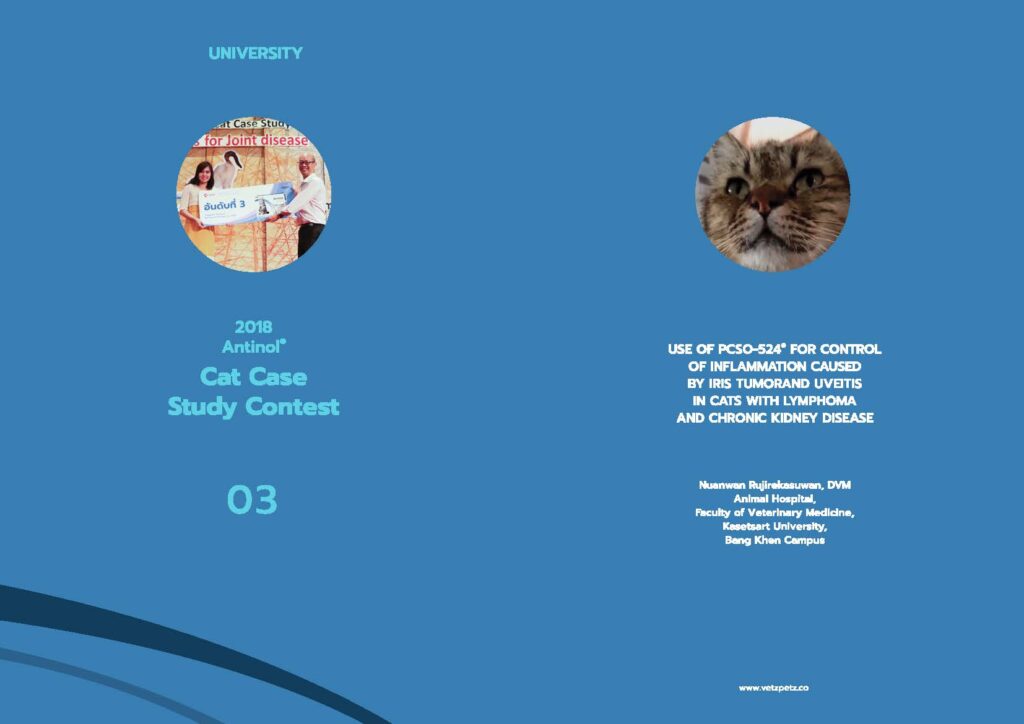

Clinical Effect of PCSO-524® on 3 Osteoarthritic Cats Associated with Chronic Kidney Disease

Three cats suffering from chronic kidney disease were admitted to animal hospital.
The first cat showed sudden onset of right hindlimb pain without apparent cause. Bladder stone was found in the second cat while the third cat was admitted for nursing care. Caging was applied and fluid therapy were administered for the third cat. All 3 cats had never been diagnosed with arthritis prior to the admission.
X-ray examination showed symptoms of arthritis at hip and stifle joints. PCSO-524® was then administered daily for 60 days.
Pain evaluation using Feline Musculoskeletal Pain Index (FMPI), which is a reliable and effective method for pain evaluation in cats (Benito et al., 2013), showed that, after the treatment, chronic pain was decreased in all of the cats (Appendix 1). The cats’ behavior was nearly normal compared with the behavior before the treatment. Interaction between the cats and owners was improved as well.
By the end of the experiment, UP/C ratio was not altered and blood creatinine tended to decrease.

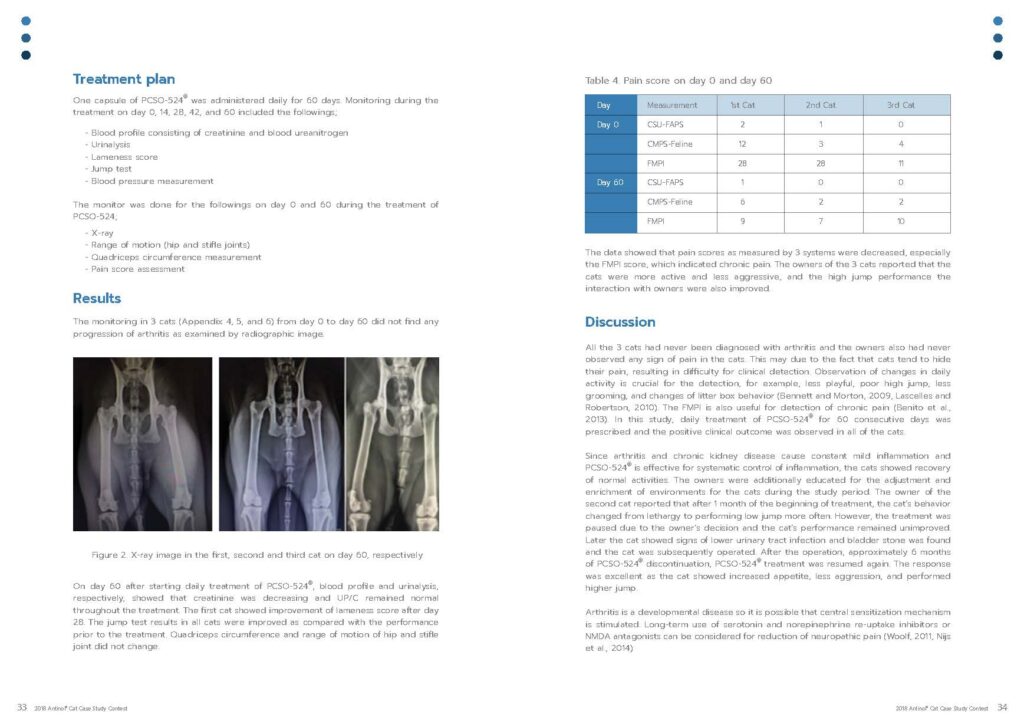
Nutraceutical Treatment of Feline Fhne and Hip Dysplasia in an 8-Month Old Cat

A Persian male cat was diagnosed with right hip luxation and left hip injury. While waiting for surgical treatment, the cat was treated with NSAIDs to control pain and inflammation.
After the operation on the right femoral head (right FHNE), the cat received antibiotics and NSAIDs for 10 and 3 consecutive days, respectively. Two weeks after the operation, the lameness and pain of the right hip, as observed from palpation, still remained, but the cat began to bear partial weight.
PCSO-524® was then prescribed and the gait analysis was performed to measure the angle of joint movement.
The monitoring showed increased angle of joint movement and decreased lameness score. This was consistent with the owner report that described less hiding behavior of the cat and improved high jump performance and better quality of life.
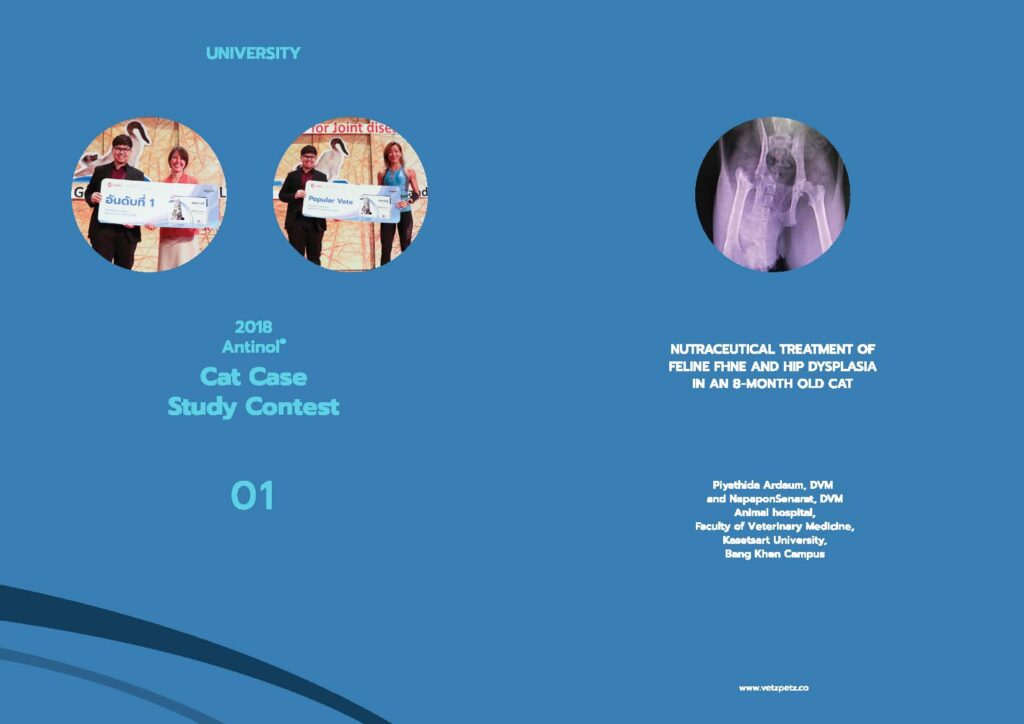
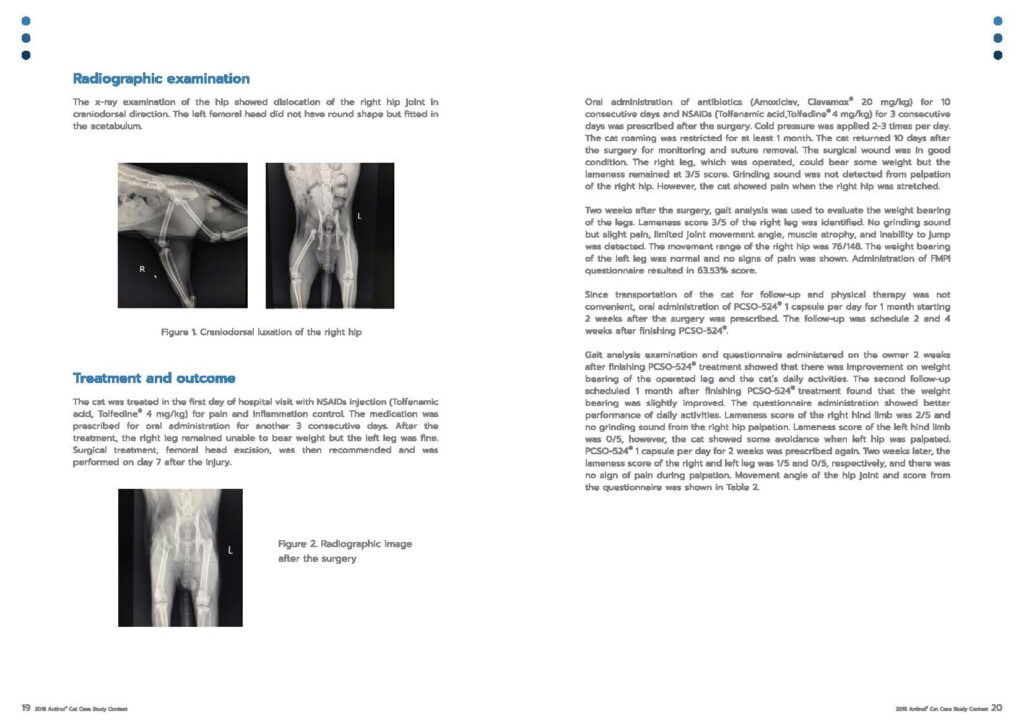
Clinical study of PCSO-524 (ANTINOL™) as neutraceutical in canine allergic skin disease

This study included 31 allergic dogs with chronic pruritis with other skin diseases excluded.
Dogs were split into 3 treatment groups based on degree of pruritis, distribution, extension of the lesions and skin and coat condition; Group 1: mild, Group 2: moderate, and Group 3: severe.
All dogs received PCSO-524 loading dose 10 mg/kg q12hr PO for 2 weeks followed by a maintenance dose of 10 mg/kg q24hr PO.
All dogs were evaluated at 2, 4, 8, 12 and 16 weeks for clinical response. The assessment made by the owners (PVAS Score) and Vets (CADESI-03 score).



Antinol® Case Study Contest 2017

10 Case Reports using PCSO-524® in combination with the treatment regimen for dogs and cats.
Pharmalink International Ltd. and Vetz Petz® would like to thank everyone involved in this 2017 Antinol® Case Study Contest competition and pay homage to our Professors and Veterinarians who have assisted in the judging of the competition.
This 2017 contest was very special with the inclusion of Professor Duncan Lascelles and the wonderful innovation of the live poll that the audience took part in to choose the Vets choice and favorite presentation.




Efficacy of PCSO-524® (VetzPetz Antinol®) for Inflammation Control in Cat with Chronic Juvenile Gingivitis Responsive to Full Mouth Extraction

The cat was having signs of juvenile gingivitis and retained deciduous dentition. Extraction of deciduous teeth were performed when the cat was 11 months old. However, gingivitis was persistent and causing severe halitosis, saliva stain on hair around the lips, drooling, and gingival overgrowth.
The cat was treated with New Zealand green-lipped mussel oil extract PCSO-524® (VetzPetz Antinol®, DKSH, Thailand) 1 capsule daily for 2 months after the extraction of deciduous teeth.
The treatment was able to reduce degree of drooling and gingivitis but could not completely eliminate the disease.
Full mouth extraction was then performed.
Post-operative care included anti-inflammatory drug, Tolfenamic acid (Tolfedine®, Vétoquinol, Best Agro; Thailand) 4 mg/kg for 3 consecutive days, Amoxicillin-Clavulanic acid (Clavamox®, Zoetis, Thailand12.5 mg/kg for 1 week, and New Zealand green-lipped mussel oil extract PCSO-524® (VetzPetz Antinol®, DKSH, Thailand) 1 capsule per day continuously.
The severity of gingivitis was rapidly decreased after the operation and within 2 weeks after the operation, the gingivitis was completely subsided.
The oil extract was administered continuously for 31 months without showing any clinical signs or impaired hematological indicators.




Updated Study Topics
New researches and publications related to PCSO-524® and its result in clnical test submitted by veterinarians on the global conferences every year and the data keeps growing with more studies conducted


 Authors:
Authors: